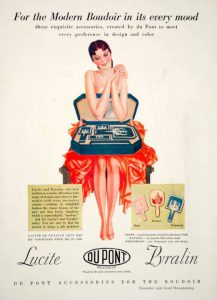Urban and other designers were involved with commercial and industrial interests but did not see this activity as separate from their quest for a modern aesthetic. Rather, designing for mass-production and marketability was a source of inspiration, leading designers to meld European ideas with modern materials and functional forms. By the late 1920s, American designers gravitated towards the aesthetic possibilities of the machine, producing ever more abstracted, austere, and machine-made objects.

“We live entirely different[ly] nowadays than we used to,” Urban once said, “and our living conditions should be altered to meet this change.” Seeking to reflect people’s modern lifestyles, Urban and other designers often incorporated new materials into their plans. Synthetic materials, such as the black Vitrolite glass cladding the Wormser bedroom’s walls and the white Pyralin inlay used to mimic ivory, were considered signs of technological progress. Moreover, they took dye well, were easily cleaned, and were inexpensive to manufacture.
